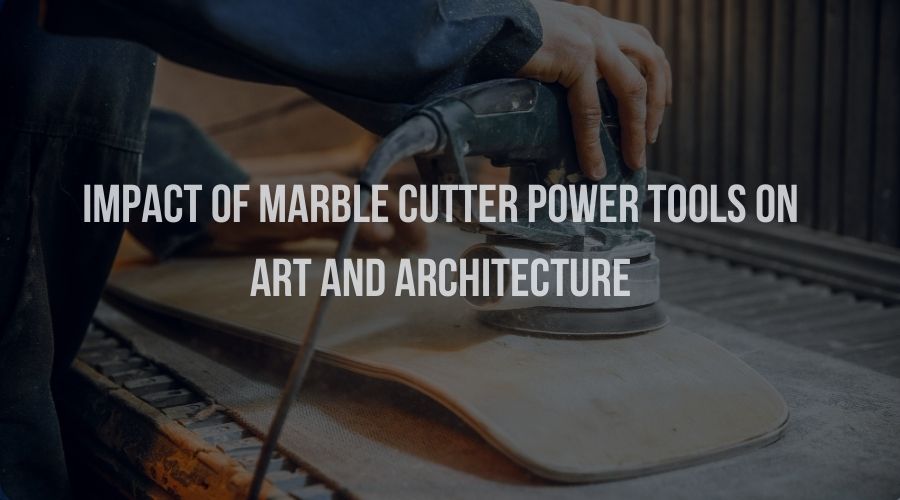Marble, with its timeless beauty and versatility, has been an integral part of art and architecture for millennia. From ancient civilizations to modern-day marvels, this exquisite stone has adorned iconic structures and sculptures, leaving an indelible mark on human history. Traditional methods of working with marble required extraordinary craftsmanship, patience, and skill. However, with the advent of marble cutter power tools, a new era of artistic expression and architectural innovation emerged.
In this blog, we delve into the profound impact of these power tools on the realms of art and architecture, exploring their historical evolution, advantages, and their potential to shape the future of design.
Traditional Marble Cutting Techniques
The art of marble cutting dates back thousands of years, with ancient artisans employing rudimentary hand tools to shape this magnificent stone. The dedication and precision displayed by these craftsmen are evident in the breathtaking structures they created. However, the painstaking process involved in manual marble cutting had its limitations. It demanded arduous physical effort and took an extended period to complete even a single masterpiece. Despite these challenges, the enduring beauty of architectural wonders like the Pantheon in Rome and the Statue of Zeus at Olympia is a testament to the ingenuity of ancient craftsmen.
Evolution of Marble Cutter Power Tools
The turning point in marble cutting came with the development of marble cutter power tools during the Industrial Revolution. Pioneers in engineering and technology sought ways to enhance the efficiency of marble cutting, leading to the creation of steam-powered and later electric-powered tools. As the 19th century progressed, advancements in engineering and the use of diamond-tipped blades revolutionised the industry. These modern power tools offered unprecedented cutting precision, transforming the way marble was shaped and opening up a world of possibilities for artists and architects.
Impact on Artistic Possibilities
Marble cutter power tools sparked a renaissance in artistic expression, empowering sculptors and artists to explore new frontiers of creativity. The enhanced precision and speed of these power tools allowed artists to breathe life into their visions with unmatched accuracy. Sculptors could now carve intricate details, delicate figurines, and ethereal forms that seemed to defy the limitations of the stone itself. Renowned artists such as Auguste Rodin and Henry Moore leveraged these power tools to craft sculptures that embodied grace and emotion, captivating audiences around the world.
Furthermore, the accessibility of marble cutter power tools democratised the art of marble carving. Aspiring artists could now experiment with this medium without the need for years of apprenticeship. This democratisation gave rise to a diverse community of talented individuals, each contributing their unique perspective to the world of marble art.
Transformation in Architectural Practices
The influence of marble cutter power tools extended far beyond artistry and permeated the field of architecture. Architects eagerly embraced these power tools as they paved the way for groundbreaking designs and construction practices. In the past, constructing marble-clad buildings was an arduous and time-consuming task, limiting the use of this majestic stone to select projects. However, with the introduction of marble cutter power tools, architects were unshackled from these constraints.
Modern architects now integrate marble into their designs with ease, creating awe-inspiring facades and intricate interior elements. From gleaming marble-clad skyscrapers to luxurious hotels, the use of this resplendent stone has transformed the urban landscape, offering a harmonious blend of tradition and innovation.
Preservation of Cultural Heritage
1. Preserving the Testaments of Time
Preserving historical marble structures and sculptures is no easy feat. Over time, weathering, pollution, and environmental factors can erode the delicate features of these monuments. But fear not, as marble cutter power tools have significantly improved restoration and conservation efforts.
2. Replicating History
Restoration specialists can now replicate missing or damaged sections with precision, using the same power tools that once shaped the original structures. This level of accuracy ensures that the restored monuments maintain their historical authenticity, providing a glimpse into the architectural splendor of the past.
Environmental Considerations
In an era where environmental responsibility takes precedence, the marble industry has embraced sustainable practices. Manufacturers have focused on developing eco-friendly marble cutter power tools that are energy-efficient and minimise waste production. Additionally, recycling initiatives have been introduced to repurpose marble waste into new materials, reducing the industry’s environmental impact.
By promoting sustainable practices, the marble industry can contribute to a greener and more sustainable future, ensuring that the beauty of this natural stone endures for generations to come.
Challenges and Limitations
1. Safety First
As with any powerful machinery, skilled operators are paramount for the safe and effective use of marble cutter power tools. Training programs and strict adherence to safety protocols are crucial to prevent accidents and damage.
2. Maintenance for Optimal Performance
Regular maintenance checks and servicing uphold the efficiency and reliability of the machines, avoiding unexpected downtime and ensuring they perform at their best.
3. Preserving Tradition
As technology progresses, concerns arise regarding the potential decline of traditional craftsmanship. Preserving the knowledge and skills of manual marble cutting is essential to maintain the cultural heritage of this art form.
Conclusion
Marble cutter power tools have left an indelible impact on the worlds of art and architecture, revolutionising the way we shape and interact with this mesmerising stone. From empowering artists to breathe life into their visions with unprecedented precision to redefining architectural practices, these power tools have enriched human creativity and craftsmanship.
Bose Power, Dice & Tricircle, the trusted brand under HR Power Tools located in the UK, offers an extensive range of power tools, equipment, and cutting tools that cater to a wide variety of needs. Whether it’s sculpting intricate sculptures or crafting awe-inspiring buildings, their tools have become an essential companion for professionals and enthusiasts alike. With Bose Power, Dice & Tricircle, the possibilities are limitless, and the pursuit of perfection in marble craftsmanship is supported by cutting-edge technology and reliability.
